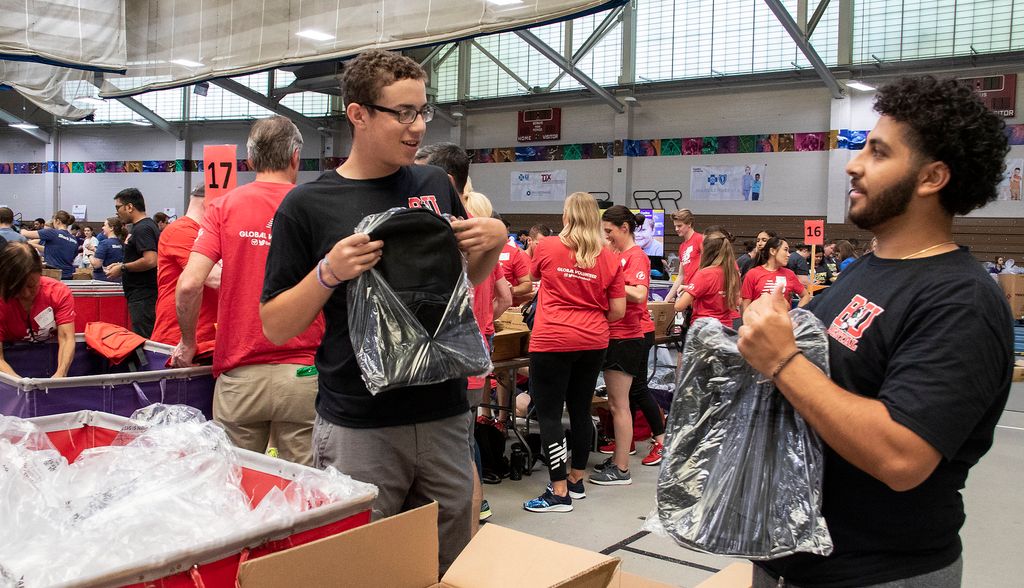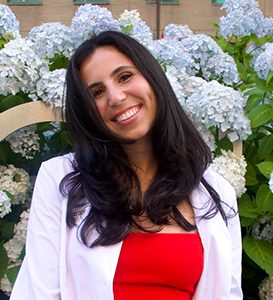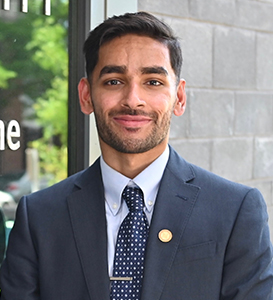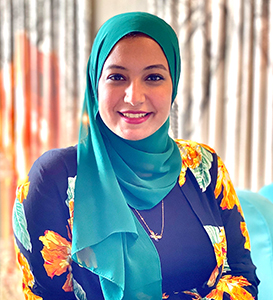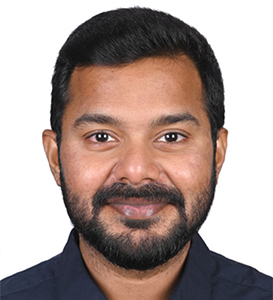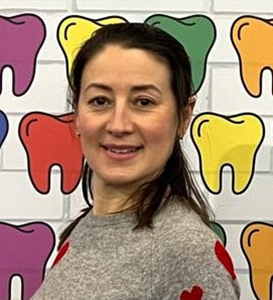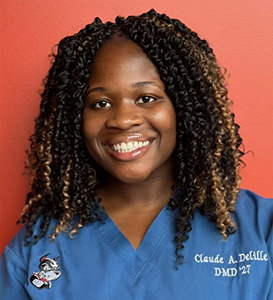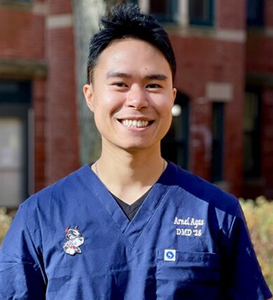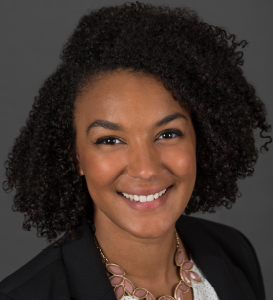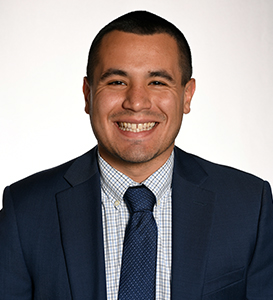Matriculation Ambassadors
The Ambassadors program was created in 2014 and is designed to support new dental students in transitioning to the rigorous and dynamic environment of dental school. Participants help with matriculation week events, provide peer mentoring, and share insight into the dental program and campus life. They help new students navigate academic expectations, familiarize themselves with Boston, and feel welcomed into the community. The program provides participants with opportunities to develop their leadership skills and it strengthen connections across cohorts, contributing to a cohesive and supportive school culture. Participants gain valuable experience in mentorship, event coordination, and peer engagement, which are critical skills for both their dental careers and professional networking.
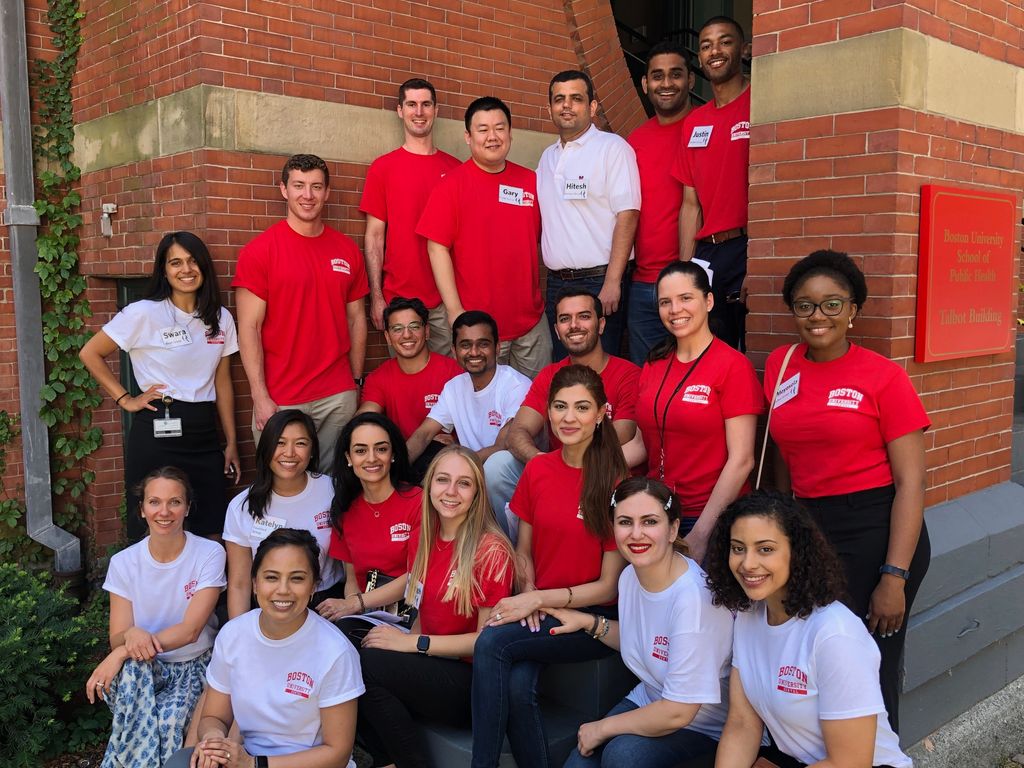
Ambassadors are GSDM predoctoral students who are assigned to lead small groups (10-13 students) during matriculation week. They help foster community and connection, serve as a resource for new students and assist staff to deliver an informative and productive matriculation experience.
Coordinators are predoctoral students who have previously served as matriculation ambassadors and are assigned to oversee certain matriculation sessions, as well as provide mentorship and support for ambassadors. Coordinators are not assigned to lead matriculation small groups, but work closely with the Student Affairs and Events & Meetings teams during matriculation week.
2025 Ambassadors
|
|
|
|
|
|
|
|
|
|
|
|
|
|
|
|
|
|
|
|
|
|
|
|
2025 Coordinators
|
|
|
|
|
What does my group title mean?
Albany Group
| Albany Street runs parallel to Harrison Avenue. It is accessible by exit 20B in the Central Artery-Tunnel from I-93 South, which is the final ramp downtown and was completed in January 2006.
On July 11, 1885, Albany Street was home to the Fire Department Shops, which were part of the Fire Department Headquarters of Boston. On August 9, 1910, they were destroyed during the Blacker and Shepard Lumber Yard fire. In the 1970’s the Fire Department Shops building was renovated into a homeless shelter. Today, the building is occupied by the Pine Street Inn. Notable locations on Albany Street include Boston Medical Center, BU School of Public Health, New England Infectious Disease Laboratory (NEIDL), Simulation Learning Center (AKA the SLC), Hidden Kitchen Restaurant, South End Pita Restaurant, and as of January 2019, the new address of the dental school. |
Black Group
| Greene Vardiman Black, commonly known as G.V. Black, is considered one of the founders of modern dentistry in the United States and the father of operative dentistry.
He was born and rasied in rural Illinois and at the age of 17 started studying medicine with the help of his brother. In 1857, he met Dr. JC Speer who taught him the practice of dentistry. He served as a Union scout during the Civil War and upon returning to Illinois, he began an active career and researcher in the field of dentistry, studying for 20 months and then completed an apprenticeship (common for the time.) He conducted research on the cause of dental fluorosis and ideal cavity preparations, invented a foot-driven dental drill, and created principles for tooth preparations where he outlined the proper way to prepare teeth for fillings. Dr. Black also organized the Classifications of Caries Lesions, which is still in use today, and created the balanced amalgam formula, which would remain the gold standard in dentistry for almost 70 years. Dr. Black was the second Dean of Northwestern University Dental School and has a statue in Chicago’s Lincoln Park. He was postumously inducted into the International Hall of Fame of Dentistry of the Pierre Fauchard Academy. |
Blue Spruce Group
| George Blue Spruce Jr. was born on January 16, 1931 at the Santa Fe Indian Hospital School.
Blue Spruce’s journey begins on the Santa Fe Indian School campus with his parents’ determination that their children would excel academically and obtain college degrees. When Dr. Blue Spruce graduated from Creighton University School of Dentistry in 1956, he was the first American Indian person to graduate from dental school. Dr. Blue Spruce spent 21 years in the Indian Health Service, worked with the World Health Organization in South America, wrote drafts of legislation of the Indian Health Care Improvement Act of 1976, and served as assistant surgeon general and director of the Indian Health Service for the Phoenix area. Throughout his journey, Dr. Blue Spruce has traveled between two cultures, succeeding in mainstream society, while keeping Pueblo tradition in his heart. Facing prejudice and conquering adversity, he reached the zenith of his career as director of the Phoenix Regional Indian Health Service and achieving the rank of assistant surgeon general of the United States. He is currently an assistant dean at the A.T. Still University/Arizona School of Dentistry & Oral Health in Mesa, Arizona, and founder of the American Indian Dental Association. Throughout his career, Dr. Blue Spruce has recruited and trained other American Indian people to enter dentistry and serve those living on American Indian reservations. |
Brown Group
| Dr. Robert Brown has been president of Boston University since 2005. A Texas native, he earned a Bachelor’s and a Master’s in chemical engineering from the University of Texas at Austin. He received his PhD from the University of Minnesota.
At BU, Dr. Brown has emphasized strengthening the core missions of the undergraduate, graduate, and professional education, interdisciplinary work, and research and scholarship across all sixteen schools and colleges. He initiated an eighteen-month planning process that culminated in a ten-year strategic plan, “Choosing to be Great”. This plan articulates BU’s core values in a set of institutional commitments and also defines goals to be met in order to establish Boston University as one of the greatest large private research universities in the world. In 2012, under Dr. Brown’s leadership, Boston University was invited to join the Association of American Universities (AAU), the organization of 62 leading research universities in the US and Canada. |
Case Group
| Harold C. Case was President of Boston University from 1951 to 1967, at the time when Dr. Goldman founded GSDM in 1963. Case was born in Cottonwood Falls, Kansas and graduated from Baker University in Kansas. He pursued graduate study at Harvard University, Garrett Biblical Institute, Northwestern University and Boston University School of Theology. He was a successful minister at several large Methodist churches across the nation before assuming the presidency of BU in 1951.
President Case continued the post-war expansion of the University, building new dormitories and establishing the School of Fine and Applied Arts (now the College of Fine Arts (CFA), the College of Engineering (ENG), and Metropolitan College (MET). He created the African Studies program in 1953, and the same year invited the distinguished African-American theologian Howard Thurman to be Dean of Marsh Chapel. President Case fostered a new campus atmosphere and he and his wife Phyllis won national recognition for their “University at Home” program, in which undergraduate students gathered at the Case’s home to discuss contemporary issues. |
Concord Group
| Concord Street is split up into two parts: East Concord Street (which starts at Biosquare Drive and runs up until Washington Street), and West Concord Street (which begins at Washington Street and continues through Tremont Street.) West Concord Street turn into Concord Sq. once it passes through Tremont Street intersection.
From 1890-1940, West Concord Street was home to the Bethany Home for Young Women. Operated by the Universalist Church, this home was open to single women of all faiths who paid a small entrance fee. It moved to 256 Newbury Street in the Back Bay where it is now known as Bethany Union, but to this day still provides affordable housing for young women. The town of Concord, Massachusetts, located about 20 minutes from Boston is also very famous. On April 19, 1775, it was the scene of the first battle of the War for Independence—the American Revolution. During the middle of the nineteenth century, a period aptly called “The Flowering of New England,” Concord was home to some of the greatest minds in America. Ralph Waldo Emerson, Henry David Thoreau, Nathaniel Hawthorne, Bronson Alcott, and his daughter Louisa May Alcott, lived, talked, and wrote in Concord. |
Freeman Group
| Robert Tanner Freeman (1846–1873) is the first professionally trained black dentist in the United States.
A child of slaves, he eventually entered Harvard University and graduated only four years after the end of the Civil War in 1869. His formerly enslaved parents took the surname “Freeman” as did countless other people after gaining their freedom from bondage. As a child, Robert befriended Henry Bliss Noble, a local white dentist in the District of Columbia. Freeman began working as an apprentice to Dr. Noble and continued until he was a young adult. Dr. Noble encouraged young Robert to apply to dental colleges. With the encouragement of Dr. Nobel, Freeman applied but was rejected. After a petition by Dr. Nathan Cooley Keep, the first dean of Harvard School of Dental Medicine, to end the school’s historical exclusion of African Americans and other racial minorities, Freeman was accepted into dental school in 1867 and became one of “the first six” to study at Harvard Dental. He was 21 years old. On March 10, 1869, Robert Tanner Freeman graduated dental school and became the first African American dentist in the United States. Dr. Freeman returned to his place of birth in Washington, D.C. after his graduation to open his own practice. He became a pillar in the District’s black community because of his commitment to mentoring other African American youth interested in the medical profession. Unfortunately, his death came in June 1873, only four years after he received his dental school degree. While working in Washington, D.C. he contracted a water-borne disease although the records are unclear as to the specific disease. Dr. Freeman’s legacy extends beyond his short life. He was honored by the National Dental Association, the all-black dental group which was founded in 1913 and is headquartered in Washington, D.C. The Association adopted the mission of Dr. Freeman to extend dental treatment and education to the impoverished, the disabled, and people of color as well as those who may not seek proper care due to age. In 1907, the predecessor organization to the National Dental Association (NDA) called itself the Robert T. Freeman Dental Society. |
Fuachard Group
|
Pierre Fauchard was a French physician and the father of modern dentistry. He is known for writing the first complete scientific description of dentistry in 1728, which described basic oral anatomy, function, oral pathology, operative methods for removing decay and restoring teeth, periodontal disease, orthodontics, tooth transplantation, and replacement of missing teeth. He joined the French Royal Navy at 15 and during that time, he observed the oral health of sailors and was encouraged to read and research more by his mentor Alexander Potelert. After his military service, he practice medicine at the University of Angers and while there, became the pioneer of scientific oral and maxillofacial surgery. He was noted for taking tools of watchmakers, jewelers, and barbers and adapting them to this dental practice. He is the pioneer of dental prosthesis, suggesting that carved blocks of ivory or bone could work just as well as natural teeth. When he moved to Paris in 1718, he realized that many of the medical libraries did not have good textbooks on dentistry and he set about to change that. His two- volume book was well received by the medical community and translated into multiple languages. Other Fauchard Highlights:
|
Goldman Group
| Henry M. Goldman had a major impact on the profession of dentistry and on the lives and careers of countless dentists around the world and is considered by many to be the father of modern periodontics.
Dr. Goldman attending Boston Latin School and graduated from Brown University in 1931. He received his DMD degree from Harvard Dental School in 1935 and began a career that spanned over 50 years. World War II interrupted his budding career and he served at the Armed Forces Institute of Pathology from 1943-1945 as the first Chief of the Dental Pathology Section for the U.S. Army. After the war, Dr. Goldman returned to Boston and became the Chief of Dentistry at Beth Israel Hospital (BIH). He created a graduate program in Periodontics and Oral Pathology and in 1955, established a collaborative program with BIH and the University of Pennsylvania Graduate School of Medicine, serving at its Professor and Chair of the Department of Periodontology. In 1960, the program became part of the Department of Stomatology at Boston University School of Medicine and this served as the beginning of the world’s first school of graduate dentistry. As its founding Dean, Dr. Goldman later began an undergraduate curriculum admitting pre-doctoral students. This became one of only two private dental schools to open in the post-war period. In 1977, the school was renamed in honor of Dr. Goldman. During his career, Dr. Goldman was a prolific writer, authoring influential dental texts that were translated in multiple languages and contributed to more than 120 articles, many of them that strongly influenced the practice of periodontology as we know it today. |
Gray Group
| Ida Gray (also known as Ida Gray Nelson and Ida Rollins; March 4, 1867 – May 3, 1953) was the first African-American woman to become a dentist in the United States.
Born in March 1867 in Tennessee, Gray was orphaned as a teenager when her mother died. Gray went to live with an aunt in Ohio and found work as a seamstress and dressmaker, before she found her way to the office of Dr. Jonathan Taft. Dr. Taft, the former dean of the Ohio College of Dentistry, was an early advocate of women being trained as dentists. Dr. Taft was recruited by the University of Michigan to help established their dental school, but kept his office in Cincinnati, which is where Gray worked for about three years. There, she learned enough to take and pass the entrance examinations for the University of Michigan School of Dentistry, and enrolled on October 1, 1887. In June 1890, Gray graduated and became the first African-American woman dentist in the United States. In 1895, she relocated her practice to Chicago, after marrying James Sanford Nelson in March of that year. Gray became a widow in 1926 and retired from dentistry in 1928. In 1929, she married her second husband, William Rollins. In addition to her dentistry, Nelson was involved in several clubs and her social activities were widely reported in the black press. She served as vice president of the Professional Women’s Club of Chicago, vice president of the Eighth Regiment Ladies’ Auxiliary and was a member of the Phyllis Wheatley Club, a group organized to maintain the only black women’s shelter in Chicago. |
Harrison Group
| Harrison Avenue runs parallel to Albany Street and Washington Street, through the heart of BU Medical Campus.
Harrison Avenue contains several notable landmarks and some of Boston’s best restaurants. Rosie’s Place, founded in 1974 as the first women’s shelter in the United States, is located at 889 Harrison Avenue. The SOWA Artist Guild, which contains galleries and working artist studios, is located at 485 Harrison Avenue. Every Sunday from May until October, SOWA hosts a Farmer’s Market as well as a Food Truck Court, where all the food trucks from the city gather in one location. Standout restaurants are Gaslight, Cinquocento, Bar Mezzana, Yellow Door Taqueira, Shojo and Estragon. If you follow Harrison Avenue downtown, it will take you right into the heart of Boston’s Chinatown, the only surviving Chinese area in New England. Boston’s Chinatown is the 3rd largest in the United States and one of the most densely populated residential districts in the city, with over 28,000 people per square mile. |
Hobbs Group
| Lucy Hobbs Taylor was the first American woman to graduation from dental school. She attended the Ohio College of Dental Surgery and graduated in 1866.
She was born in New York and worked as a teacher in Michigan for 10 years, before moving to Cincinnati with every intention to become a dentist. When she was refused admission, she started studying privately with a professor from Ohio College of Dental Surgery. In 1861 she started her own practice in Cincinnati before moving to Iowa and gaining acceptance to the Iowa State Dental Society in 1865. In November 1865, she was allowed to enter dental school and graduate in 1866. She married in 1867 and along with her husband James Taylor, practiced dentistry in Kansas, until his death in 1886. She did not practice much after James’ death, but became politically active, campaigning for women’s rights until her death in 1910. By 1900, almost 1,000 women had followed Hobbs Taylor into the profession, inspired by her accomplishments. In 1983, the American Association of Women Dentists created the Lucy Hobbs Taylor Award, which is presented annual to members recognize professional excellence and achievement in advancing the role of women in dentistry. GSDM’s own, Dr. Kady Rawal, was named 2016 Woman to Watch. |
Hutter Group
|
Jeffrey W. Hutter was the third Dean of the Boston University Henry M. Goldman School of Dental Medicine. Dean Hutter was appointed Dean in August 2008. He served as Senior Associate Dean, Professor and Herbert Schilder Chair of the Department of Endodontics and Director of the school’s postdoctoral program in Endodontics. From 2002 until his appointment as Senior Associate Dean, he was the school’s Associate Dean for Academic Affairs. He joined GSDM in 1997. A diplomat of the American Board of Endodontics (ABE), Dr. Hutter is a past director of both the ABE and the Board of Directors of the American Association of Endodontists (AAE), and a past AAE president. Dr. Hutter retired with the rank of Captain from the United States Navy Dental Corps in 1996 after a 21-year career. His last assignment was Chair of the Department of Endodontics and Director, Postdoctoral Endodontics at the Naval Dental School, Bethesda Maryland. Upon retirement from the Navy and prior to assuming his position at Boston University, he was Director, Postdoctoral Endodontics at the School of Dentistry, University of Maryland. Dr. Hutter holds a DMD degree from the University of Pennsylvania, a Certificate in Endodontics from the Naval Postgraduate Dental School; and an MA in Education and Human Development from The George Washington University. |
Leone Group
|
Cataldo W. Leone was appointed Dean of the Henry M. Goldman School of Dental Medicine in November 2021 after serving as the school’s Associate Dean for Academic Affairs since 2008. Dean Leone assumed the role at a very exciting time for the Goldman School, following the completion of a major three- year expansion and renovation of its Albany Street home. Dean Leone has been a member of the faculty at Boston University since 1999, joining the University as an associate professor of periodontology and oral biology, before being promoted to full professor in 2006 and to assistant dean for academic affairs in 2007. His academic interest focused on educational methodologies and curriculum design and directs several predoctoral and postdoctoral courses. Dean Leone is a recent past chair of the BU Faculty Council. In addition, Dean Leone has received numerous teaching awards as well as serving on countless committees at the local and national levels in higher education. He has authored dozens of publications in top-tier refereed journals and his research has been supported by the National Institutes of Health and the US Department of Health and Human Services. Dean Leone earned his DMD from the University of Pittsburgh School of Dental Medicine in 1983 and then completed a Certificate of Advanced Graduate Studies in Periodontology in 1987 and a Doctor of Medical Sciences in Oral Biology in 1989 at Harvard University. Prior to joining Boston University in 1999, he was an assistant professor of periodontology at the University of Florida, and then an associate professor of periodontology and director of the postdoctoral periodontology residency program at Tufts University. |
Newton Group
| Newton Street is parallel to Massachusetts Avenue and the Boston University Henry M. Goldman School is located at the corner of E. Newton Street and Albany Street.
Newton Street has two parts – East Newton Street and West Newton Street. East Newton Street begins at Biosquare Drive and runs up until Washington Street, where it switches to West Newton Street and becomes a one way going to other way. Newton Street has a street level bus station on the MBTA Silver Line at the intersection of Washington Street. The South End branch of the Boston Public Library is located on the corner of West Newton St. and Tremont St. Blackstone Square and Franklin Square are public parks located at the intersections of Washington Street and Newton Street. Charles Bulfinch, who created the plan for the South End, originally intended the two squares to be one, calling it Columbia Square. Franklin Square opened in 1849 and Blackstone Square subsequently opened in 1855. The St. James Hotel, now the Franklin Square House Apartments, served as the exterior backdrop of the popular 1980’s NBC hospital drama series, St. Elsewhere. In 1979, after years of neglect, local resident Brian Davidson began an effort to clean up the squares. He personally picked up trash and after several years the city of Boston began a revitalization project that included new fences, fountains, benches, and trees. If you walk up E. Newton St toward the city, you will come to a connection to the Southwest Corridor, a linear urban park. It extends almost 5 miles (8 km) from Forest Hills section of Jamaica Plain to the South End & Back bay and features tennis courts, basketball courts, playgrounds, and walking, jogging, and biking paths. |
Scarlet Group
|
Scarlet, along with White, are the official colors of Boston University. When you graduate from dental school, you will wear a scarlet gown with three lilac bands on the sleeves, to signify dentistry. Scarlet is a bright red with a slightly orange tinge. In the spectrum of visible light, and on the traditional color wheel, it is one-fourth of the way between red and orange, slightly less orange than vermilion. According to surveys, scarlet and other bright shades of red are the colors most associated with courage, force, passion, heat, and joy. The word comes from the Middle English “scarlat”, from the Old French escarlate, from the Latin “scarlatum”, from the Persian saqerlât . An early recorded use of scarlet as a color name in the English language dates to 1250. Scarlet in popular culture:
|
Schilder Group
|
Herbert Schilder was Professor and Chair (41 years) in the Department of Endodontics at Boston University Henry M. Goldman School of Dental Medicine. He had a distinguished career in dental education, organized dentistry and in the clinical practice of endodontics. Dr. Schilder held many national leadership roles in Endodontics, as well as serving as the First Vice President of the American Dental Association. Dr. Schilder was recognized internationally as a practitioner, innovator and educator in endodontics. Dr. Schilder has written 100 scientific articles and contributed chapters to numerous textbooks on endodontics. He lectured at numerous dental meetings, in 25 countries and on every continent. Dr. Schilder introduced to the profession the predictability of healing of lesions of endodontic origin, defined the principles of cleaning and shaping and developed the vertical compaction of warm gutta percha technique. He is the recipient of numerous awards and citations from dental schools and dental societies in this country and abroad. Dr. Schilder received his BA and DDS from New York University. Following dental school Dr. Schilder completed a three year Teaching- Research Fellowship in Endodontics at Temple University. Dr. Schilder has trained more than 350 endodontists. Several years ago Boston University Goldman School of Dental Medicine, created the Herbert Schilder Chair in Endodontics, funded by his former graduate students and friends. |
Shawmut Group
| Shawmut Group is named after Shawmut Avenue, which is just a couple of blocks up from the dental school.
Shawmut is a term derived from the Algonquian Native American word Mashauwomuck referring to the region of present-day Boston and the peninsula on which the city was built. It appeared very early in print in the history of New England – as far back as 1630! The meaning may refer to the salt water around Boston or to the fresh water springs found nearby. This word appears in several place-names, not all of which can be traced with certainty to the Mashauwomuk place name.
Notable foodie spots on this city street are El Centro and Orinoco, serving excellent Mexican and Latin American foods, the South End Buttery Bakery, Coppa, and Kava, a new Mediterranean restaurant. |
Silber Group
|
John Silber was the president emeritus and former chancellor who led the transformation of Boston University from a commuter school to a renowned research institution. A strong-willed man, he was outspoken, and often controversial, but his work ethic, capacity for knowledge, and determination to improve both BU and the city of Boston made him well known in academic as well as political circles. During his tenure at BU, he greatly expanded the campus, recruited top-notch faculty, including two future Nobel Prize winners, and established the University’s long-running partnership with the Chelsea Public School system, which began in 1988 and continued for 20 years. The University he served for so long awarded him an honorary degree at the 1995 Commencement. He also ran (unsuccessfully for governor of Massachusetts in 1990). Silber, who came to the University in 1971, was BU’s seventh president, serving for more than three decades, as president until 1996, then as University chancellor from 1996 to 2003. He also was a College of Arts & Sciences professor of philosophy and of international relations, a University Professor, and a School of Law professor of law. |
Sinkford Group
|
Jeanne Craig Sinkford is a dental educator, administrator and pioneer from the nation’s capital where she later became the first female dean of any dental school in the nation upon her appointed to the position in 1975 at her alma mater Howard University’s College of Dentistry. After completing her studies at the Northwestern University School of Dentistry Dr. Sinkford started her career in dental education by joining the faculty for a year before returning home to the Howard University College of Dentistry in 1964 to chair the prosthodontics department. She was the first woman head of such a department in the nation. Dr. Sinkford was made associate dean of the College of Dentistry in 1967. Dr. Sinkford was appointed dean in 1975 where she held the position for 16 years until she retired in 1991. That same year, she became professor and dean emeritus, and was appointed director of the Office of Women and Minority Affairs at the American Dental Education Association (ADEA) in Washington, D.C. In 2015, Dr. Sinkford became a senior scholar-in-residence with ADEA, her work focusing on recruitment and promoting growth of minority and women students and faculty. Dr. Sinkford holds memberships in the American Prosthodontic Society, the International Association of Dental Research, the National Dental Association, the Institute of Medicine, the National Academy of Sciences, Phi Beta Kappa, and Alpha Kappa Alpha Sorority. She also serves as an American College of Dentists and International College of Dentists fellow. Dr. Sinkford’s numerous awards include Alumni Achievement Awards from Northwestern University and Howard University in 1970 and 1976, one of the first Candace Awards from the National Coalition of 100 Black Women in 1982, the 1984 Award of Merit from the American Fund for Dental Health, the 2007 Trailblazer Award from the National Dental Association, and the 2010 Fauchard Gold Medal. She is also the recipient of five honorary doctorate degrees. Dr. Sinkford graduated from Dunbar High School in 1949, and earned her BS degree in psychology and chemistry from Howard University in 1953. In 1958, Dr. Sinkford graduated at the top of her class with a DDS degree in dental surgery from the Howard University College of Dentistry. She then taught prosthodontics at Howard’s College of Dentistry before graduating from Northwestern University School of Dentistry with her MS degree in 1962, and her PhD in physiology in 1963, making her the first female prosthodontist with a PhD. |
Springfield Group
| Springfield Street runs parallel to Massachusetts Ave and is split into East Springfield, which starts at Harrison Avenue and runs up until Washington Street, and West Springfield Street, which begins at Washington Street and continues through Shawmut Avenue, when it then become Wellington Street and connects into the Southwest Corridor.
This street is lined with beautiful old brownstones and cobblestone sidewalks (so watch your step if you’re out for an afternoon stroll). At the corner of E. Springfield and Harrison, you’ll find Blunch, a sandwich spot that features the best bagel sandwiches in Boston. The city of Springfield, Massachusetts, is also very famous. The Eastern States Exposition (“The Big E”) is located there and serves as the New England states’ collective State Fair. It is the 6th largest agricultural fair in America and features rides, music, exhibitions, and serves the most famous food from all six New England states. Springfield, MA was the first in the New World and the largest city in Western New England. It is nicknamed the City of Firsts, because of its innovations, the City of Homes, because of its Victorian residential architecture. But Springfield is probably most famous as the Hoop City as the sport of Basketball was invented there by James Naismith in 1891. |
Tremont Group
| The name “Tremont” is a variation of one of the original appellations of the city, “Trimountaine,” a reference to a hill that formerly had three peaks. Much of the Trimountain was removed, and the earth used as fill to expand the Shawmut Peninsula.
The two smaller peaks, Cotton Hill (what is now Pemberton Square) and Mt. Vernon, (formerly at the location of the modern-day Louisburg Square) no longer exist. The central peak, now called Beacon Hill, with its single peak, is all the remains of the Trimountain. It is smaller than the original peak, which reached approximately to the height of the top of the State House. The street is unique among streets in Boston in that the name zigzags across several physical streets, much like Francis Lewis Boulevard in New York City does. Sites of interest along Tremont Street, from northeast to southwest, include Government Center, King’s Chapel, Granary Burying Ground, Park Street Church, Boston Common, Masonic Grand Lodge, Boston Theater District, and Our Lady of Perpetual Help Basilica. Tremont Street Subway in Boston’s subway is the oldest subway tunnel in North America, opened on September 1, 1897. It was originally built to get streetcar lines off the traffic-clogged streets. It now forms the central part of the Green Line, connecting the Boylston, Park Street, and Government Center stations. |
Washington Group
| Washington Street is the longest street in Boston, and it remains as one of the longest streets in the state of Massachusetts. In fact, it extends all the way to the Massachusetts – Rhode Island border.
The majority of it was built as the Norfolk and Bristol Turnpike in the early 19th century. Washington Street was the first street that connected peninsular Boston to the mainland and as a result, it serves as the divide where a number of cross streets change names. The part of Washington Street between downtown Boston and Dudley Square in Roxbury was the first road connecting Boston to the mainland, carrying the Boston Post Road to New York City. The city of Boston has four additional Washington Streets. The Washington Streets in the Dorchester neighborhood and Allston-Brighton neighborhood are two of the other significant streets, while the ones in Hyde Park and Charlestown are two additional minor streets. Notable spots on Washington Street, near the South End include Toro Restaurant, Jaho Coffee Shop, Flour Bakery & Café, Foodie’s Market, Franklin Square & Blackstone Square, and Myers & Chang. |
Wells Group
|
Horace Wells was an American dentist who pioneered the use of anesthesia in dentistry, specifically nitrous oxide. Dr. Wells was born in Vermont and educated in New Hampshire before coming to Boston to study dentistry. After receiving his degree, he set up practice in Hartford, Connecticut with Dr. William Morton, who himself would become famous for his use of ether as an anesthetic in 1846. He first witness the effects of nitrous oxide in 1844 when he agreed to let a member of a traveling circus try it on him. Later that year, he became the first patient to be operated on under anesthesia when he had a tooth extracted by his fellow dentist, Dr. John Riggs. Dr. Wells then began to use it on his own patients, but never patented the discovery because he said that pain relief should be “as free as the air.” In 1845, Wells was performing a demonstration to students at Massachusetts General Hospital but the nitrous was improperly given and the patient cried out in pain. This blunder caused him to be discredited in the medical community and ultimately to give up dentistry to become a travelling salesman in Connecticut. The American Dental Association honored Wells posthumously in 1864 as the discoverer of modern anesthesia and the American Medical Association recognized his achievement in 1870. |
Worcester Group
| Worcester Group is named after the street located in the South End, close to the medical campus and the city of Worcester. The word Worcester comes from the Old English meaning roman fort or walled city, war-castle. Located 40 miles west of Boston, the city is the 2nd most populous city in New England and is known as the “Heart of the Commonwealth” due to its geographic center of Massachusetts. Modern day Worcester is known for its diversity and large immigrant population including Vietnamese, Brazilians, Albanians, Puerto Ricans, Ghanaians, Dominicans, and others.Worcester Square is part of the South End Landmark District and features a fountain and statue designed and fabricated by artist Gene Cauthen. The brownstones along the square date back to the 18th century. |
